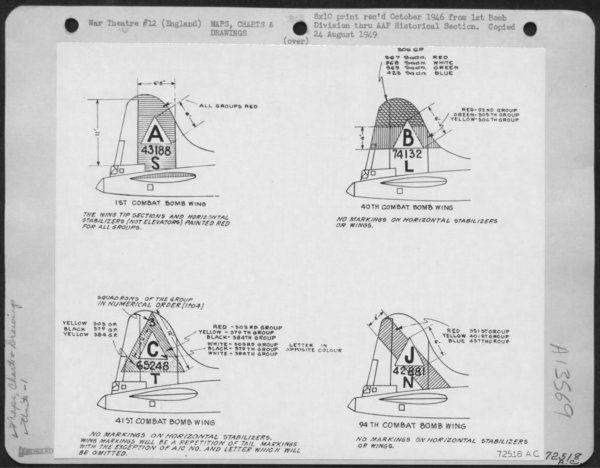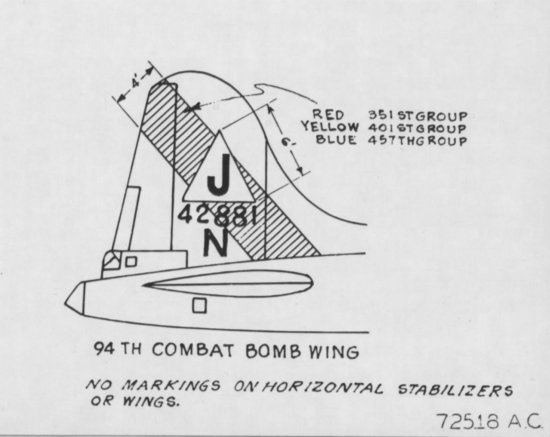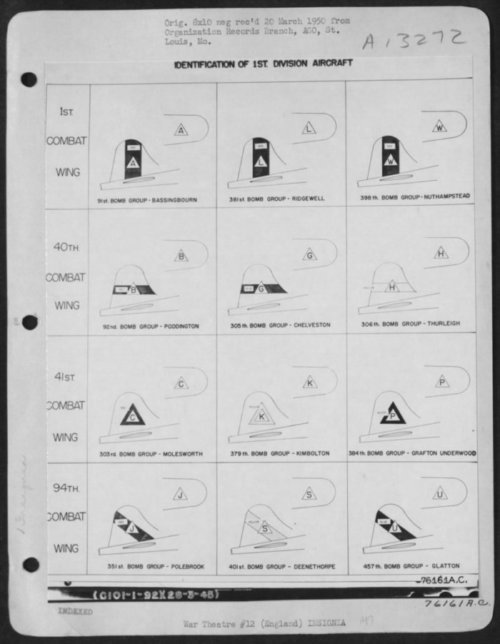In December 1943, at Wendover Army Air Base, 71 B-17’s were assigned to the 457th Bomb Group.
| A/C 42-31505 | A/C 42-31588 | A/C 42-31635 | A/C 42-38104 | A/C 42-97466 |
| A/C 42-31517 | A/C 42-31591 | A/C 42-31636 | A/C 42-38110 | A/C 42-97467 |
| A/C 42-31520 | A/C 42-31592 | A/C 42-38021 | A/C 42-38113 | A/C 42-97468 |
| A/C 42-31531 | A/C 42-31594 | A/C 42-38055 | A/C 42-97443 | A/C 42-97469 |
| A/C 42-31541 | A/C 42-31595 | A/C 42-38056 | A/C 42-97450 | A/C 42-97470 |
| A/C 42-31542 | A/C 42-31596 | A/C 42-38057 | A/C 42-97451 | A/C 42-97471 |
| A/C 42-31545 | A/C 42-31607 | A/C 42-38058 | A/C 42-97452 | A/C 42-97473 |
| A/C 42-31547 | A/C 42-31613 | A/C 42-38060 | A/C 42-97455 | A/C 42-97477 |
| A/C 42-31548 | A/C 42-31615 | A/C 42-38063 | A/C 42-97456 | A/C 42-97478 |
| A/C 42-31551 | A/C 42-31618 | A/C 42-38064 | A/C 42-97457 | A/C 42-97481 |
| A/C 42-31552 | A/C 42-31620 | A/C 42-38065 | A/C 42-97458 | A/C 42-97488 |
| A/C 42-31568 | A/C 42-31627 | A/C 42-38066 | A/C 42-97459 | |
| A/C 42-31572 | A/C 42-31629 | A/C 42-38073 | A/C 42-97460 | |
| A/C 42-31586 | A/C 42-31630 | A/C 42-38102 | A/C 42-97464 | |
| A/C 42-31587 | A/C 42-31633 | A/C 42-38103 | A/C 42-97465 |
Before the air echelon left Grand Island on the 17th of January, three B-17’s had already crashed:
1. 42 – 31541; William Snow crashed on December 23rd 1943
2. 42 – 31547; Lt. Ashby crashed on January 3rd 1944
3. 42 – 31586; not sure if this A/C number is right
The aircraft left Grand Island 17 January, part of them landing at Presque Isle, Maine and part at Grenier Field, Manchester, New Hampshire. From there the planes flew the transatlantic flight individually, some making landings at various points such as Gander Lake, Newfoundland, Prestwick, Scotland, Nuts Corner and Ireland.
Two aircraft crash landed on arrival at Nutts Corner:
1. 42 – 97443; Lt. Donald Karr crashed on January 20th 1944
2. 42 – 97459; Lt. Tracy Geiger Jr crashed on January 23rd 1944
The first nine aircraft were reported as arrived from the USA on 20th January but when the first daily report of aircraft assigned was made on 22nd January only eight planes were listed. It is thought that the ninth was 42-31572 which was assigned to the 91st Group on 23rd January. Twenty-three aircraft landed in North Platte, and the remaining ships scattered at various air bases in that vicinity. This was due to continued bad weather, all ships being unable to land at Grand Island. Most of the remaining aircraft arrived during the next week but some were delayed into February. The planes were dispatched to Burtonwood over the next three weeks for modifications, some making two visits, the extended period over which the aircraft were being modified at Burtonwood resulted in alternative plans being made to get the 398th Bomb Group, due to arrive in the First Division in April, more speedily into combat.
At the end of March 1944, the 457th had been operational for just six weeks. The group’s most noticeable statistics was that despite being the junior of the Division, it had had more B-17G assigned than any of the other Groups and also had more natural metal finished planes assigned. Both these factors were due to the decision taken early in March that the 457th would become the Eighths first ‘All Silver’ Group as a result many of the original painted aircraft were transferred out. Later in March a change of plans was made and it was decided that the Group would only have half its completement of aircraft ‘silver’ and as a result many of the silver planes assigned in as part of the original policy were then transferred to other groups. The group had 66 operational B-17’s of which 31 in Natural Metal Finish. 26 of these aircraft belonged to the original group that was assigned to the group at Wendover Army Air Base in December 1943.
The group was assigned a triangle U Group marking which was a 72in-sided white equilateral triangle with a 36in Insignia Blue letter U thereon. On the upper surface of the right wing the triangle had 96in sides and the letter U was 57in high, with colors as on the tail. An individual aircraft call-letter, either 36in or 48in high, was painted below the tail number in yellow. The 48in letter was the size most commonly used on replacement aircraft but 36in and 24in letters were also to be seen. All four squadrons used letters in alphabetical order from A, excluding C, E and I. These exclusions are not known ever to have been used as call-letters in the 457th Bomb Group.

The Triangle U on these aircraft was a white letter on black and the call-letter was also in black. In the summer of 1944 the squadrons were distinguished by colored propeller bosses.
– 748th Bomb Squadron RED
– 749th Bomb Squadron BLUE
– 750th Bomb Squadron WHITE
– 751st Bomb Squadron YELLOW
In August 1944 the aircraft call-letter followed by the last three digits of the serial number, was painted in approximately 12in high characters on both sides of the nose, directly aft of the bombardiers Plexiglas; the colour was yellow on camouflage and black on bare metal. On some aircraft the call-letter was omitted and this later became general practice relative to nose numbers. A number of aircraft had the call-letter, approximately 20in high, painted on the chin turret sides during the final months of hostilities. In August 1944 a 48in wide Insignia Bleu stripe was painted diagonally across the vertical tail, the lower end forward and the higher end at the top of the rudder. On most aircraft the Group insignia, tail number and call-letter were left with a bare metal margin. This was also the process when painting most replacements, although smaller call-letters were more general and 20in high letters were used on several aircraft, most commonly in the 751st Bomb Squadron. In mid May 1945 the current wireless telegraphy codes were used in the anti-low flying program as an under wing identity marking. This suggests that the 457th Bomb Group squadrons had for some reason been omitted from the SD110 publication.
The W/T (= Wireless Telegraph) codes used, plus the aircraft letter as a sufflix, were as follows:
– 748th Bomb Squadron RUW,
– 749th Bomb Squadron JOB,
– 750th Bomb Squadron PPL
– 751st Bomb Squadron MJA

At the end of the war the inventory of the 457th Bomb Group shows that there were 46 aircraft were still at Glatton. All of these aircraft were flown back to the US where they were sold for scrap.
| 748th Bomb Squadron | 749th Bomb Squadron | 750th Bomb Squadron | 751st Bomb Squadron |
|---|---|---|---|
| A/C 44-6509 | A/C 43-38540 | A/C unknown | A/C 42-97123 |
| A/C 44-6951 | A/C 43-37733 | A/C 43-38865 | A/C 42-97827 |
| A/C 42-97190 | A/C 43-38534 | A/C 43-38528 | A/C 42-97587 |
| A/C 43-38394 | A/C 43-38594 | A/C 43-37694 | A/C 43-38885 |
| A/C 43-38844 | A/C 43-39080 | A/C 43-39195 | A/C 43-38887 |
| A/C 43-38506 | A/C 43-39087 | A/C 43-38855 | A/C 43-38707 |
| A/C 43-37785 | A/C 43-37828 | A/C 43-38857 | A/C 43-38240 |
| A/C 43-38479 | A/C 43-37574 | A/C 42-37551 | A/C 43-38301 |
| A/C 43-39072 | A/C 43-39200 | A/C 42-97535 | A/C 43-38947 |
| A/C 43-39092 | A/C 44-8832 | A/C 43-38582 | |
| A/C 44-8902 | A/C 44-6904 | A/C 43-38749 | |
| A/C 43-37826 | A/C 44-6161 | A/C 43-39154 | |
| A/C 44-6621 |




I have a signed by 3 pilots poster dedicated to Michael Orkins. Trying to learn more about these 3 pilots
42-97075 was assigned to 750BS 457th BG according to several sources which includes a clear photo.